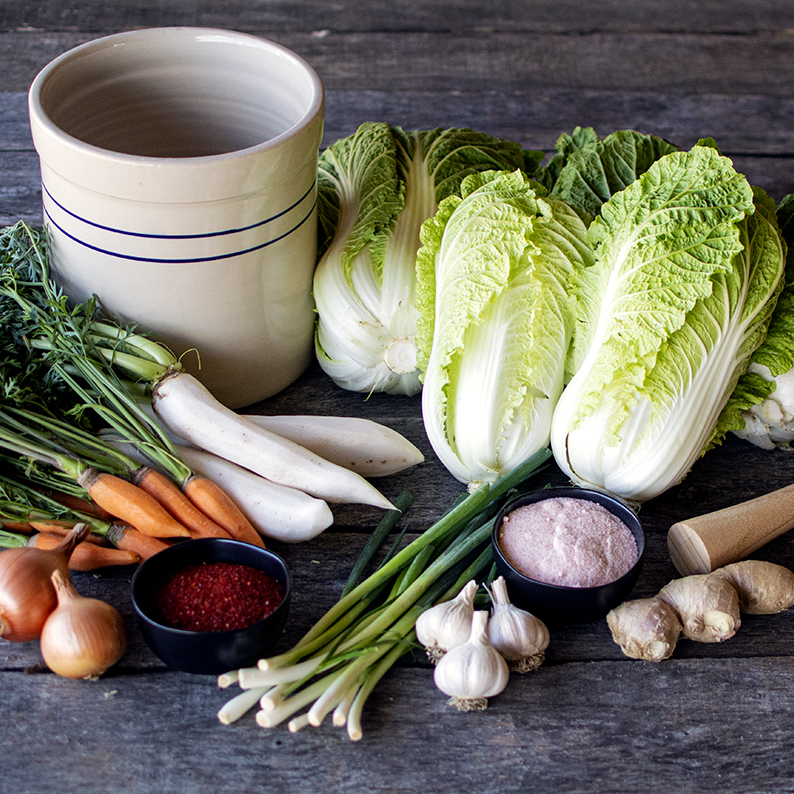

Kimchi is a staple dish in Korean cuisine made of salted and fermented vegetables. The name kimchi encompasses any vegetable that is fermented in the Korean style. Believe it or not, there are almost 200 documented types of kimchi!
Many people are familiar with the traditional napa cabbage kimchi also known as baechu kimchi. It usually includes napa cabbage, radish, and gochugaru (Korean chili pepper powder) with a few additional spices and vegetables. In Korea, kimchi is traditionally eaten as a side to every meal or even incorporated into the main dish.
In addition to being a delicious accompaniment to meals, kimchi has numerous health benefits. It is known to improve digestive health because it is chock-full of probiotics. Kimchi also contains many vitamins and antioxidants including folate, beta-carotene, choline, potassium, vitamin A, vitamin C, and vitamin K, and calcium.
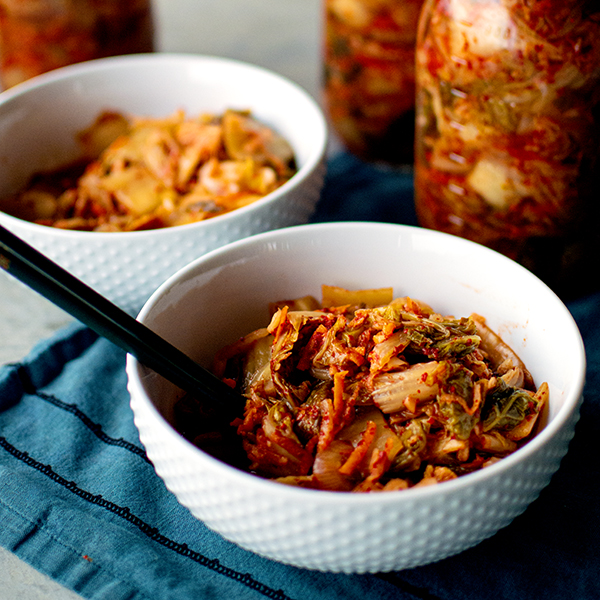 Kimchi is surprisingly easy to make at home. Our family makes traditional napa cabbage kimchi, with a little bit of variation in the vegetables based on what we have available in the garden.
Kimchi is surprisingly easy to make at home. Our family makes traditional napa cabbage kimchi, with a little bit of variation in the vegetables based on what we have available in the garden.
The recipe below uses napa cabbage, daikon radish, garlic, ginger, gochugaru, carrots, scallions or Chinese chives, and a yellow onion. These vegetables are all in season in fall with the exception of the yellow onion and garlic, which are cured and stored from a summer harvest.
Gochugaru (Korean chili pepper powder) may be tricky to find locally. You can check Asian markets or the ethnic foods section at your grocery store. It is much easier to find and obtain online. Or if you plan ahead early, you can grow your own Korean peppers and make homemade gochugaru!
If you want authentic kimchi flavor the gochugaru is a must-have! I personally think it is worth the effort to buy or grow. But if you would like to try a substitute, cayenne pepper flakes or chipotle powder can be used as an alternative. Keep in mind the results will be quite different because cayenne peppers are spicier and chipotle peppers are smokier than gochugaru.
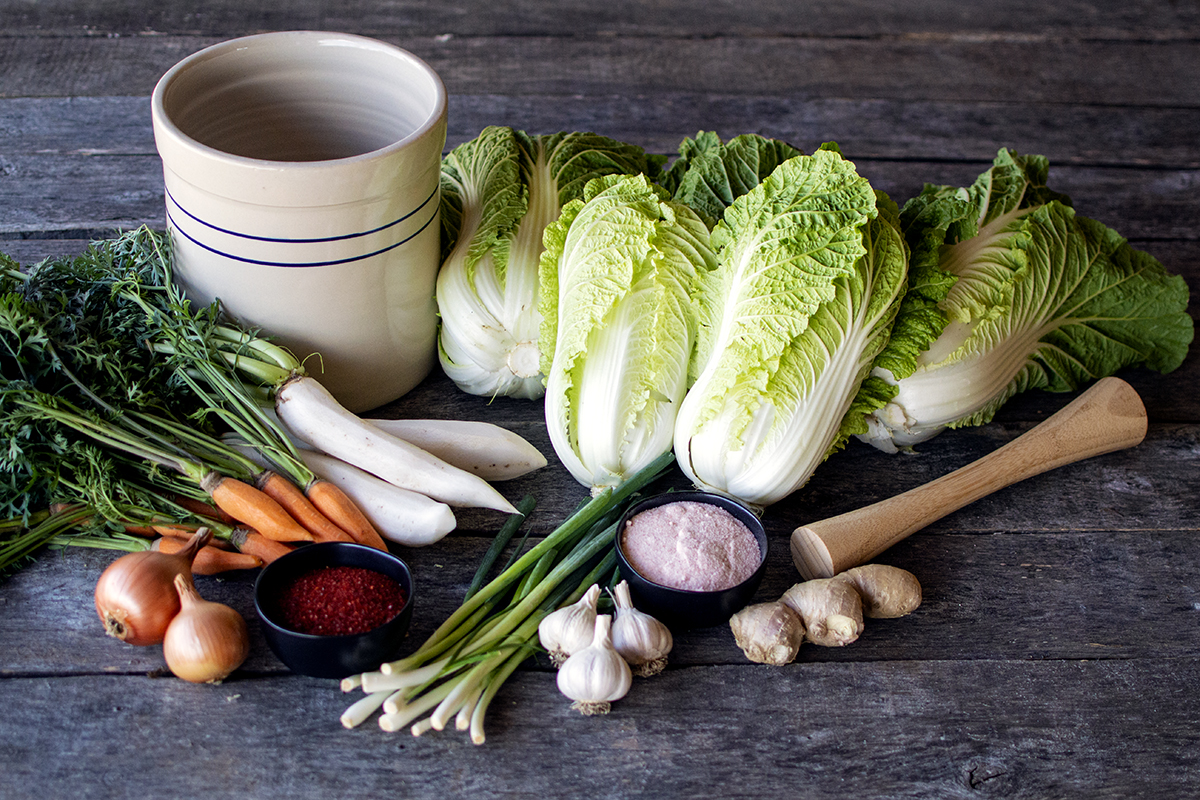 2 Gallon R&H Homestead Stoneware Crock
2 Gallon R&H Homestead Stoneware Crock
2 Gallon Ohio Stoneware Fermentation Crock Weights
Cabbage Stomper
Mason Jars for storing
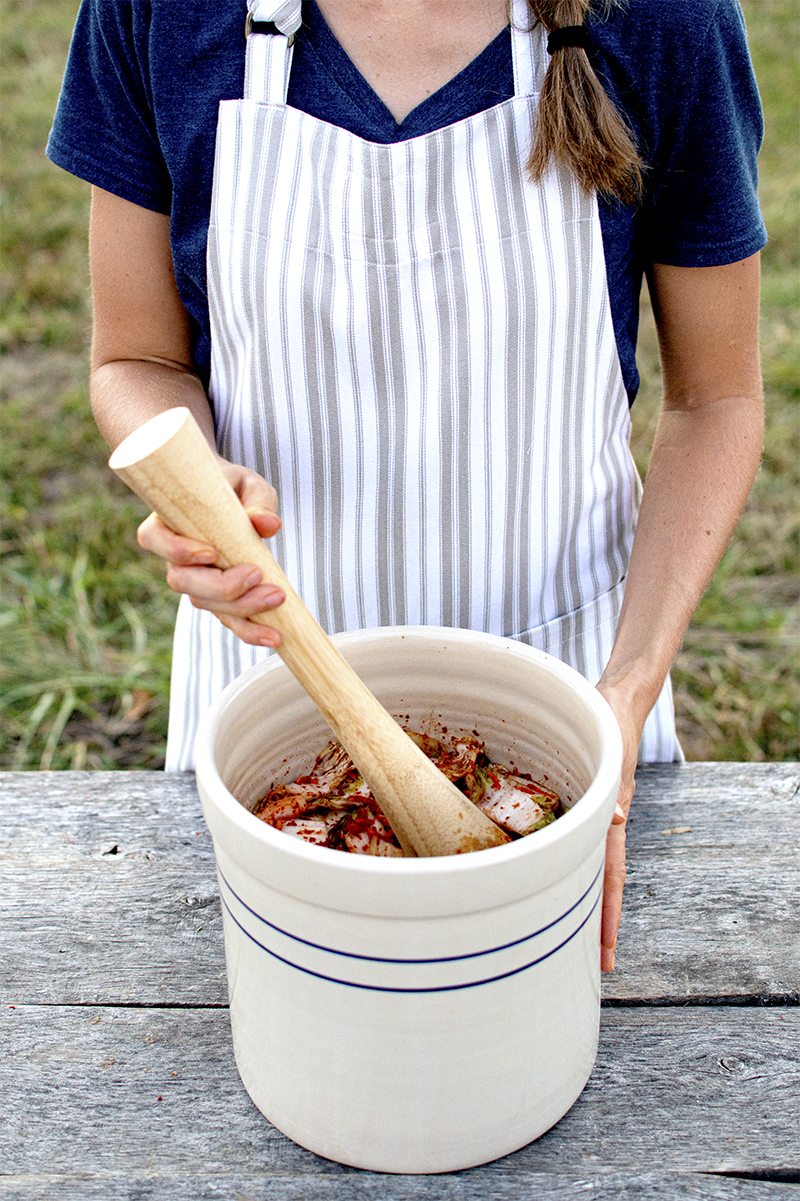 For the Brine:
For the Brine:
- 2 gallons unchlorinated water
- 2 cups unrefined sea salt
For the Kimchi:
- 10lbs napa cabbage (4-5 large heads)
- 2 cups shredded daikon radish
- 2 cups shredded carrots
- 18 cloves garlic, peeled and minced
- 1 small yellow onion, sliced very thin
- 1 cup Chinese chives or scallions, sliced into ½ inch pieces
- ¼ cup ginger, peeled and minced
- 1 cup gochugaru (Korean chili powder)
- 1 tablespoon sugar (optional)
- 3 cups reserved liquid from the brine
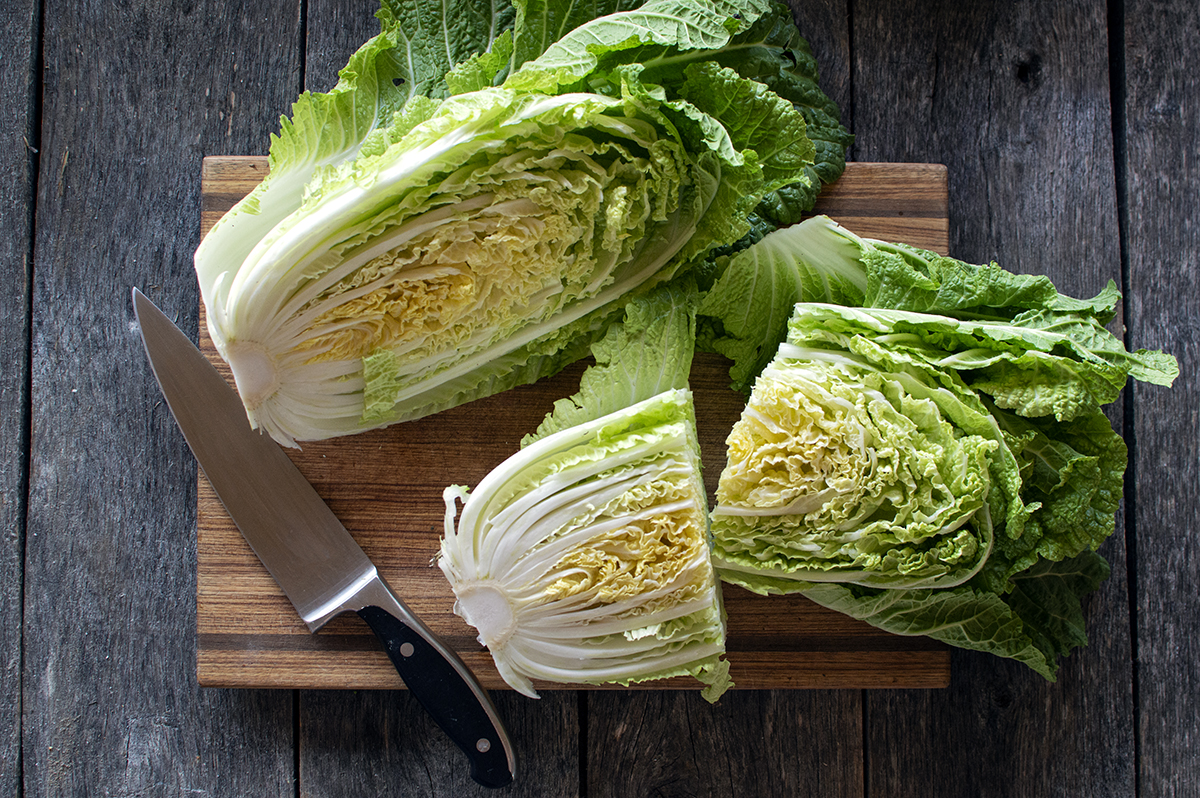 1. Prepare the brine by mixing the water and sea salt together in a very large mixing bowl until the salt dissolves. You can also split the brine into two bowls using 1 gallon of water and 1 cup of salt per bowl if your bowl isn’t big enough.
1. Prepare the brine by mixing the water and sea salt together in a very large mixing bowl until the salt dissolves. You can also split the brine into two bowls using 1 gallon of water and 1 cup of salt per bowl if your bowl isn’t big enough.
2. Wash the cabbage in cool water.
3. Remove and reserve a few of the large outermost leaves of the cabbage for later.
4. With the remaining cabbage, slice the cabbages into quarters and place into the brine.
5. Add a plate over the top of the cabbages. Then add your weights over that to keep the cabbage submerged in the brine.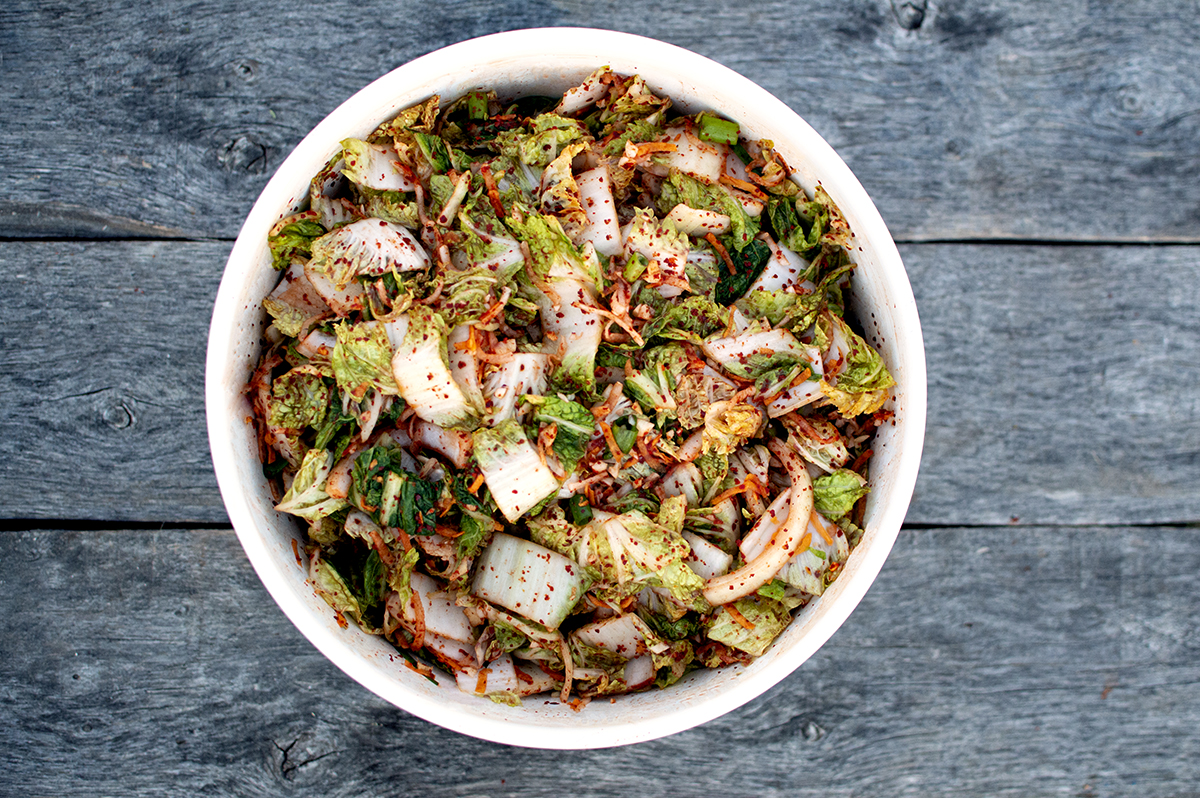
6. Let the cabbage soak in the brine for 4-6 hours.
7. After soaking, reserve 3 cups of brine and set aside. (Don’t forget this step!)
8. Then drain the cabbage in a colander.
9. Chop cabbage into bite size pieces and place in a very large bowl.
10. Add radishes, carrots, garlic, onion, Chinese chives, ginger, gochugaru, and sugar. Mix well.
11. Transfer the mixed vegetables and spices into your fermentation crock a little at a time, using the stomper to firmly push down the vegetables, Packing as tightly as possible.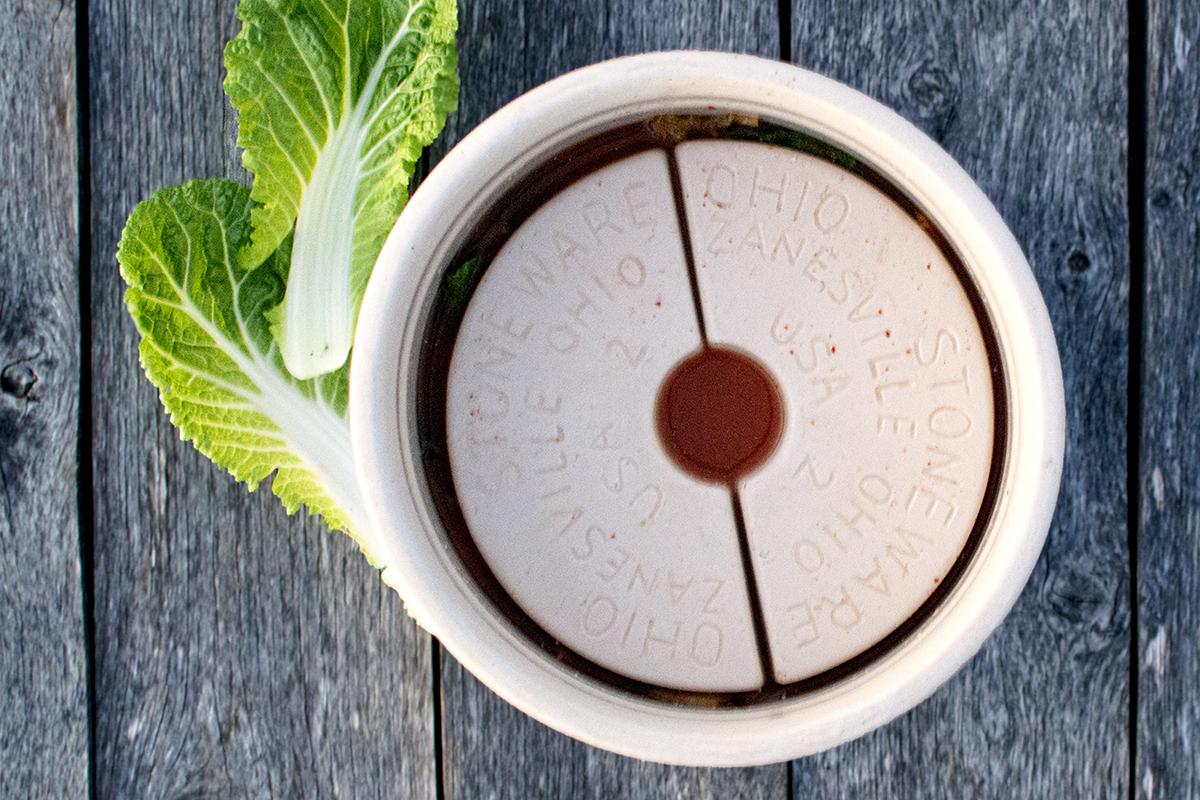
12. Once all the mixture is in the crock and stomped down, add the reserved whole cabbage leaves over the top. This will create a cover to keep the chopped vegetables from coming out of the brine and floating to the top.
13. Place your weights on top.
14. Add 2-3 cups of the reserved brine. It should cover all the vegetables but only a little bit. Additional liquid will release from the vegetables during the first few days of the ferment.
15. Cover the crock with a plate, lid, or towel, and let ferment in a cool, dark area for 7-28 days. You can begin taste testing at 7 days. The longer you ferment the more pickled the flavor will become.
16. When the ferment is finished, remove kimchi from the crock and place in individual mason jars with lids. Recipe yield is approximately 5 quarts of kimchi.
17. Kimchi should be stored in the refrigerator when the ferment is finished. It can also be stored in a root cellar as long as it hovers between 32 and 40ºF. Under these conditions, kimchi will stay fresh for nine months to one year.
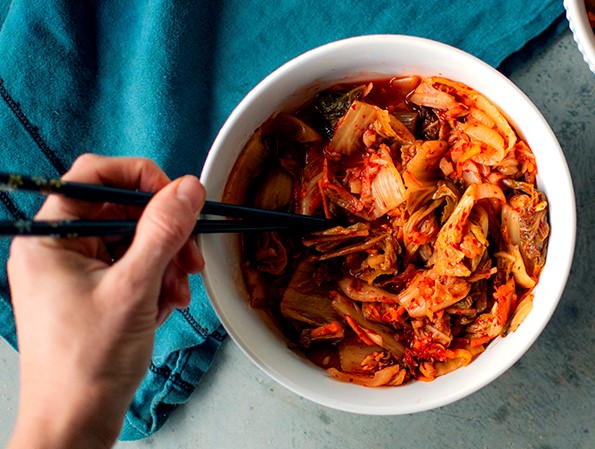 Sometimes during the fermentation process you’ll see a white film form on the top of the brine. This is called scum and is harmless. Use a sieve to scoop off any film you see.
Sometimes during the fermentation process you’ll see a white film form on the top of the brine. This is called scum and is harmless. Use a sieve to scoop off any film you see.
Instead of adding sugar, try adding a ¼ cup Asian pear, julienned.
You can also experiment with different vegetables and amounts to your taste. Just be sure to keep the salt to water ratio in the brine the same. Salt helps keep the bad bacteria away and helps the good bacteria to flourish.
Ideal fermentation temperature is between 55 and 75ºF. When fermenting in a room temperature at the warmer end of the spectrum the fermentation process happens faster. On the cooler end of the spectrum it will take longer to ferment.
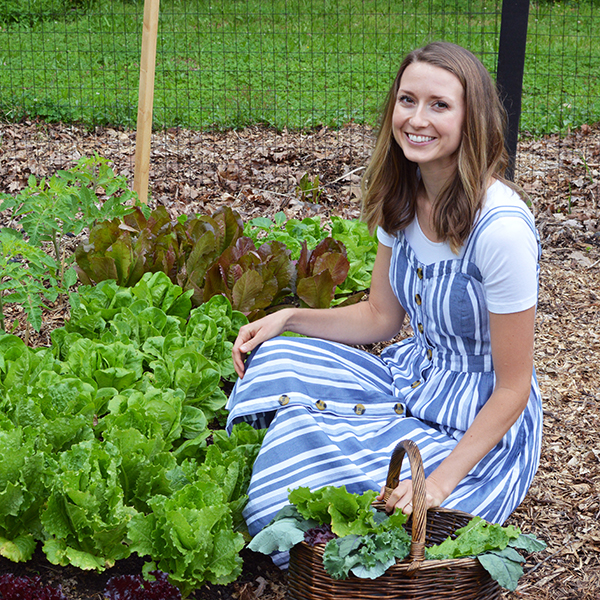 Becky Porter is the writer and content creator behind The Seasonal Homestead. She is passionate about gardening, preserving, and self-sufficiency. Becky is also a professional artist and uses her artistic background in her homestead work. She, along with her husband and four children, homestead on a 52 acres in Arkansas, where deciding what seeds to grow or what farm animals to add is an almost daily topic of conversation.
Becky Porter is the writer and content creator behind The Seasonal Homestead. She is passionate about gardening, preserving, and self-sufficiency. Becky is also a professional artist and uses her artistic background in her homestead work. She, along with her husband and four children, homestead on a 52 acres in Arkansas, where deciding what seeds to grow or what farm animals to add is an almost daily topic of conversation.